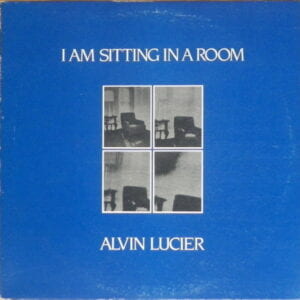“I am sitting in a room different from the one you are in now. I am recording the sound of my speaking voice, and I am going to play it back into the room again and again, until the resonant frequencies of the room reinforce themselves, so that any semblance of my speech, with perhaps the exception of rhythm, is destroyed. What you will hear, then, are the natural resonant frequencies of the room, articulated by speech. I regard this activity not so much as a demonstration of a physical fact, but more as a way to smooth out any irregularities my speech might have.”
—— Alvin Lucier

I was sitting in the 4F IMA studio on a Monday morning, listening to the tape I am sitting in a room by Alvin Lucier. I felt quite dull at the beginning with the repetition of a man’s speech. Around 4-5 minutes later with a dozen of playback, his sound became electronic and metallic. My mind started to wander far away in the Cosmo, immersed in the feeling that hundreds of thousands of sci-fi movie soundtracks overlapping themselves and being extracted their essence and gathered into one man’s sound. I started to feel safe somehow with the certainty of what was going to play in the next few minutes. While my familiarity with the original sound began to fall apart, I was in strange thrill and fear as well. With the senses of certainty and unfamiliarity tangled with each other in my head, I was lost in time and space. In the later part of the soundtrack, I kind of came back from the far distance to the room I was in, where the sound seemed to touch every object, chair, and wall as it passed through them. The shapes of things in my field of vision seemed integrated with the music-like sound at the time. I even hoped to stay much longer when it came to an end, totally in awe at the hundreds of playbacks mixing together.
I’d love to quote one of the comments that I found interesting. “…As I listened it gave me a weird thought. That somehow this is what we would hear if we finally picked up on alien communications, distorted by resonant frequencies through the cosmos.” The comment just provided another perspective of thinking, which I guess can be related to my feeling of certainty and unfamiliarity while listening. Sometimes we are too familiar with something, a language, a cultural concept, or a convention, that we never sense the necessity to step back and value them, no matter how it would sound in another form (e.g., a speech being played back many times) or its relationships with other objects (e.g., the relationship between the sound and the architecture). The sense of unfamiliarity helps us view things in another dimension. I also love how Mary Lucier used a similar conceptual process in visual form to recreate the original work done by Alvin. She used a Polaroid copier to reproduce the original images. The two different mediums, intended for the same art concept, were beautiful and thought-provoking indeed.
The article also discussed how an experimental music performance can be acquired by a museum, which I believe is a very important field for museums to think through and dig deeper. Sound and music shouldn’t just serve as assisting tools to display visual artwork. Instead, they themselves, if empowered by contemporary artists and museums, can be powerful artwork that conveys excellent art concepts. As sound and music have a closer relationship with the environment where they are played, they may provoke wonderful thoughts and connections from the audience if they are played in a well-considered space.
